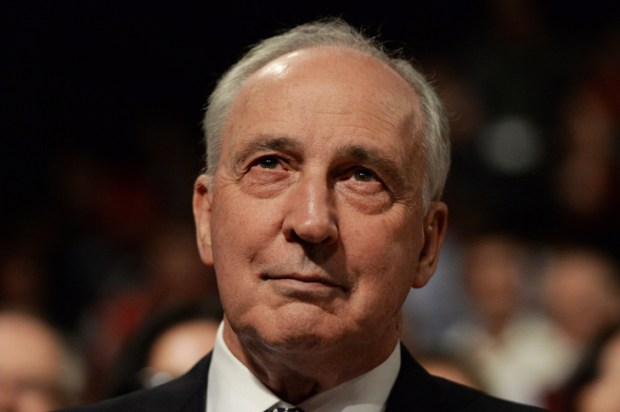‘NOW is Not the time for Business AS usual,’ read the grumpy boy’s placard as he munched on an apple blocking Waterloo bridge in London, this April. Despite Apple Boy’s protestations, it certainly looked like business as usual for the End of the World brigade.
True, there were innovations; activists glued themselves to various forms of public transport (giving a whole new meaning to ‘getting stuck in traffic), including one who glued her naked breasts to the roadway. A pink boat painted with the words ‘Tell the Truth,’ was dragged into central London which inspired Tory MP and former Lord Mayor of London Boris Johnson to do his bit, suggesting that ‘Surely this is the time for the protesters to take their pink boat to Tiananmen Square and lecture them in the way they have been lecturing us.’
The Extinction Rebellion protesters, as they call themselves, held mass ‘die-ins’ around the world last Saturday. Protesters in Glasgow held a ‘die-in’ under Dippy the Dinosaur’s skeleton and held up signs asking, ‘Are we next?’ Holding up traffic in Tiananmen Square seems like a pretty safe way of ensuring an answer in the affirmative, at least for any participants.
The Australian chapter of the rebellion organised a ‘die-in’ on the steps of Flinders Street station at which 100 people and a giant bug — Kafka’s salesman perhaps? — turned up. Its miniscule number suggested that the placard proclaiming, ‘We’re bug-gered’ might apply to the movement itself rather than humanity.
Australian Extinction Rebels have been urged by their website to ‘get to the front line to #StopAdani before it starts!’ Dispatches from the battlefield suggest the movement has not found many converts in coal country.
‘You’ve got a choice, Adani or your children, but you can’t have both,’ threatened former Greens leader, Bob Brown, in the central Queensland mining town of Clermont. Even by the Greens standards, the statement sounded a lot like blackmail, and it didn’t go down well with the locals, who, unlike Dr Brown, do have children and don’t have parliamentary pensions, plumped up by taxes on coal exports, on which to retire.
It is precisely because they want a future for their kids that includes jobs and affordable, reliable electricity that Dr Brown and his coal-fired convoy of convenience were heckled by locals carrying signs that read ‘proud coal mining family’, ‘Start Adani,’ and ‘Go home and turn off your power and walk.’
It would be fair to say that the Greens never met a coal mine they liked, but why Adani’s has been singled out, as a ‘killer’ mine, as the Greens put it in their policy platform, is not clear. Over 7,269 million tonnes of coal were mined worldwide in 2016 (the most recent figure available.) Almost half of that — 3,243 million tonnes — was mined in China, which has increased coal production by 139 per cent since the turn of the millennium. Australia produced 503 million tonnes of coal in 2016. Adani’s Carmichael mine is expected to produce around 40 million tonnes of coal on average per annum, a tiny fraction of global production. So why pick on Adani?
Dr Brown tries to justify the hysteria by claiming that coal is the new heroin and says the coal industry is employing ‘the heroin dealer’s lament — if I didn’t do it somebody else would.’ It underlines the illogicality of the Greens, who are agitating for a utopia in which it will be legal to shoot up heroin but illegal to dig up coal. In reality, as the president of the mining and energy division of the CFMEU in Queensland, Steve Smyth points out, ‘Adani is just being used as a stalking horse for activists’ who want shut down all thermal coal mines.
The Extinction Rebellion was created by about 100 academics and the former Archbishop of Canterbury, Rowan Williams. It’s not surprising to see this mix of the secular and the religious. The end of the world has been a long time coming – the Essenes predicted the second coming of Jesus and the final battle as foretold in Revelations would occur in AD 66 or thereabouts which seems a little overdue. Pope Sylvester the Second predicted apocalypse now in the year 1000, which had all the accuracy of the Y2K bug a millennium later.
Prophets of ecological apocalypses haven’t had any greater success rate than popes. Harrison Brown, a scientist at the National Academy of Sciences, said the world’s supply of lead, zinc, tin, gold and silver would have been exhausted by 1990 and copper shortly after the year 2000. Ecologist Kenneth Watt claimed that by the year 2000 we’d be using up crude oil at such a rate that there wouldn’t be any. ‘You’ll drive up to the pump and say, “Fill ‘er up buddy” and he’ll say, “I am very sorry, there isn’t any”.’ Peter Gunter, a professor of philosophy at North Texas State University, warned in 1970 that, ‘Demographers agree almost unanimously on the following grim timetable: by 1975 widespread famines will begin in India; these will spread by 1990 to include all of India, Pakistan, China and the Near East, Africa…. By the year 2000, thirty years from now, the entire world, with the exception of Western Europe, North America and Australia, will be in famine.’
That the eco-catastrophists are here at all, let alone that they are organising die-ins, is rich in irony. The great grand-daddy of the doomsters, Paul Ehrlich, wrote in 1969, in an essay entitled Eco-Catastrophe! that between 1980 and 1989 four billion people would perish in the ‘Great Die-off’, including 65 million Americans. Fifty years later, he admits he made ‘a bunch of mistakes,’ but despite his dismal track record at crystal ball gazing, he’s still shamelessly forecasting that the ‘collapse of civilisation is a near certainty within decades.’ The failure of their forecasts to materialise does not act as a deterrent. Democratic congresswoman Alexandra Ocasio-Cortez makes Professor Ehrlich look like an optimist claiming ‘the world is gonna end in 12 years’ if climate change is not addressed.
But Apple Boy on Waterloo Bridge is unlikely to be troubled by any of this. Even on the days he isn’t participating in the ‘global school strike 4 climate action’, his teachers are unlikely to pollute his childish mind with inconvenient truths that might sow the seeds of doubt since they will almost certainly have studied in the gloomy groves of academe that engendered the extinction movement in the first place. One thing no-one is predicting is that the spirit of the die-ins will die out anytime soon.
Got something to add? Join the discussion and comment below.
Get 10 issues for just $10
Subscribe to The Spectator Australia today for the next 10 magazine issues, plus full online access, for just $10.
You might disagree with half of it, but you’ll enjoy reading all of it. Try your first month for free, then just $2 a week for the remainder of your first year.














Comments
Don't miss out
Join the conversation with other Spectator Australia readers. Subscribe to leave a comment.
SUBSCRIBEAlready a subscriber? Log in